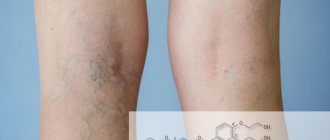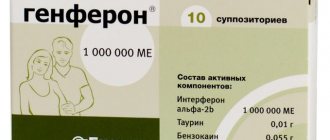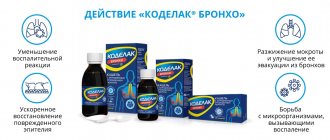Composition and forms
Sinekod is produced in drops for oral administration, specially created for young patients under 3 years of age, and syrup for older children and adults.
The main active ingredient in the drops is butamirate citrate – 5 mg. The secondary components are:
- sorbitol 70%,
- saccharinate;
- benzoic acid;
- ethanol 96%;
- water – 1 ml.
The syrup contains the main active ingredient – butamirate, 1.5 mg per 1 ml. Excipients are:
- sorbitol solution 70%;
- literol;
- benzoic acid;
- ethanol 96%;
- water about 100 ml.
pharmachologic effect
The therapeutic properties of Sinecode are aimed at relieving dry cough. The drug is used comprehensively as a symptomatic treatment.
The medication has a pronounced bronchodilator effect and helps normalize breathing during a coughing attack. Also helps restore spirometric values.
Regardless of the form produced, the medicine is quickly absorbed by the body. The required pharmacological effect is observed 1-1.5 hours after application. There is no accumulation of product components. The excretion of Sinekod products is carried out through the excretory system.
Mechanism of action
Sinekod is an antitussive drug. It, being a non-opioid drug, suppresses cough. At the same time, it is not addictive and does not form dependence. The effect of taking butamirate is explained by its direct effect on the cough center, as a result of which the cough reflex is suppressed, which occurs both when the mucous membranes of the respiratory tract are irritated and when the cough center itself in the brain is toxic. In addition, the drug has a bronchodilator effect, expanding the lumen of the tubular passages. After administration, breathing becomes easier due to a decrease in the resistance of the lower respiratory tract. Sinekod helps saturate the blood with oxygen.
Sinekod
Sinecode (active ingredient - butamirate) is an original drug for the symptomatic treatment of dry cough of a wide variety of etiologies. Cough is a protective reaction of the body that occurs when receptors in the respiratory tract are irritated. In most cases, it indicates the presence of some disease, most often the respiratory system. Adequate pharmacotherapy of cough is the most important task facing modern medicine. After determining the exact cause of the cough, treatment of the underlying disease begins, which is supported by taking medications for symptomatic therapy, the action of which can be aimed both at suppressing the cough and at increasing its productivity (mucoactive drugs). Suppression of the cough reflex is required in cases of dry, non-productive cough that does not fulfill its cleansing function. Such a cough significantly worsens the quality of life of patients and can threaten hemodynamic disturbances in the thoracic region, vomiting, hemoptysis, and diaphragmatic hernia. Medicines that inhibit the cough reflex can affect the cough center (central action) or the sensitivity of cough receptors (peripheral action). Among the first, a distinction is made between narcotic and non-narcotic drugs. Moreover, despite all the effectiveness of narcotic drugs, their use is associated with many undesirable side reactions. A significant advance in the treatment of dry cough has been the creation of new centrally acting antitussive drugs, comparable in effectiveness to narcotic drugs, but without such a severe side effect. Of significant interest in this aspect is the centrally acting antitussive drug Sinecode from the Swiss pharmaceutical corporation Novartis. In terms of its chemical structure and pharmacological “habits,” the active substance of sinecode, butamirate, in no way resembles opium alkaloids. Unlike morphine derivatives, the effect of butamirate on the cough center is selective, due to which sinecode is devoid of sedative and analgesic effects, does not cause pathological dependence and does not depress the respiratory center.
The effectiveness of the drug does not decrease even with long-term treatment, and the peak of its effect is achieved after the first use. In comparison with other drugs of this pharmacological group, Sinecode is endowed with a number of advantages, the main of which are high efficiency, favorable safety profile and good tolerability. Clinical trials have shown that the drug causes virtually no unwanted side effects even after long-term use: only in rare cases can skin rashes, dyspeptic disorders and dizziness occur. As already mentioned, sinecode can be used for non-productive cough of any etiology, as well as for cough center hypersensitivity syndrome that occurs as a consequence of a previous respiratory disease. The drug not only reliably blocks all “body movements” of the cough center, but also exhibits an anti-inflammatory and expectorant effect, dilates the bronchi, reduces the resistance of the respiratory tract and promotes oxygen saturation of the blood. Clinical studies have demonstrated the effectiveness of sinecode against both new-onset and chronic debilitating dry cough. The drug is characterized by a pronounced, long-lasting and rapid therapeutic effect, which begins to manifest itself already 1 hour after administration (in which it is clearly superior to codeine-containing drugs). Butamirate is quickly and completely absorbed in the gastrointestinal tract. Its half-life is 6 hours. Not only butamirate itself has an antitussive effect, but also its metabolites formed in the blood.
Sinekod is available in two dosage forms: drops for oral administration and syrup. The drops are used in pediatric practice, starting from 2 months, and the syrup is indicated for adults and children from 3 years of age.
Interaction
Sinekod does not interfere with the absorption of antibiotics and does not affect their concentration in the blood. However, it should not be taken simultaneously with mucolytic and expectorant drugs that produce sputum. Simultaneous use of the drug Sinekod with expectorants and mucolytic drugs will lead to pneumonia of bacterial etiology, since the removal of sputum will be impossible due to suppression of the functions of the cough center. The mucus produced will not be coughed out, but will instead begin to accumulate in the lungs, causing bacteria to multiply.
special instructions
The medicine contains sweeteners, so it is used with caution for people with diabetes.
As a result of the presence of ethyl alcohol in the base, the prescription to patients with a tendency to pharmacological and alcohol dependence, people with pathologies of the liver, kidneys, epilepsy and pregnant women occurs according to strict indications.
The drug can cause drowsiness, so it is recommended to avoid driving during the course.
Dosage
The drug does not treat dry cough, but only temporarily relieves the symptom. It is advisable to take the drug strictly at night to get rid of an irritating sensation in the respiratory tract, a suffocating cough that interferes with sleep. It should be remembered that cough is a symptom of illness, not a disease. Only by getting rid of the cause (bacterial, fungal or viral infection, allergen, toxins) causing the cough can you forget about the unpleasant symptom.
A single dose for syrup is:
- children from 3 to 6 years old – 5 ml;
- children from 6 to 12 years old – 10 ml;
- children over 12 and adults – 15 ml.
A course of taking the drug for several days or even weeks is possible for severe forms of whooping cough. In this case, the dosage and duration of administration are determined by the attending physician. Drops are taken in the following volumes:
- children of the first year of life are given up to 10 drops at a time;
- children from one to 3 years old – 15 drops per dose;
- For children over 3 years of age, a single dose is increased to 25 drops.
Instructions for use of Sinecode
The antitussive is intended for the treatment of adults and children over 2 months of age. The dose and duration of the course depend on the age of the patient.
In pediatric practice, drops and syrup are used. For adult patients - pills and syrup.
Sinekod tablets should not be chewed or crushed; they should be swallowed and washed down with the required volume of water.
To combat cough, whooping cough, bronchitis and other pathologies, the following is prescribed:
- Adults - 15 ml of syrup up to 4 times a day.
- Patients over 18 years old: 2 tablets three times a day.
- Children - the therapeutic dose is calculated depending on age. There are drops for the little ones.
The course of treatment with Sinekod should not exceed a week. You should start taking the medicine as prescribed by a specialist.
Overdose
If you take the drug excessively, the following side effects are possible:
- drowsiness;
- weakness;
- nausea;
- diarrhea;
- skin rashes.
At the first signs of drug poisoning, you should immediately stop taking it and perform gastric lavage. In severe cases, sorbents are taken to speed up the removal of absorbed substances from the blood. Further treatment should be discussed with your doctor to replace Sinekod with an analogue or stop symptomatic therapy.
Side effects
The drug rarely provokes the development of side effects. When used, the following may occur:
- Headache.
- Nausea followed by vomiting.
- Sleep disturbance - accompanied by insomnia and drowsiness.
- Reduced blood pressure levels.
- Stool disorder.
- Symptoms of allergic reactions are itching, skin rashes, eczema. In some cases, urticaria is observed.
Treatment in this case is symptomatic. It is important to see a doctor.
Sinecod®
Suction
Based on available data, it is assumed that butamirate ester is rapidly and completely absorbed and hydrolyzed in plasma, turning into 2-phenylbutyric acid and diethylaminoethoxyethanol.
The effect of food on absorption has not been studied. The change in the concentration of 2-phenylbutyric acid and diethylaminoethoxyethanol occurs in proportion to the dose taken in the range of 22.5 mg - 90 mg.
Butamirate is rapidly and completely absorbed when taken orally, with measurable concentrations detected in the blood 5-10 minutes after administration of doses of 22.5 mg, 45 mg, 67.5 mg and 90 mg. Maximum plasma concentrations are achieved within 1 hour when taking dosages at all 4 levels, the average is 16.1 ng/ml when taking an oral dose of 90 mg.
Average plasma concentrations of 2-phenylbutyric acid are achieved within 1.5 hours; the maximum concentration was observed after a dose of 90 mg (3052 ng/ml); average plasma concentrations of diethylaminoethoxyethanol are reached within 0.67 hours; Cmax is observed after taking a dose of 90 mg (160 ng/ml).
Distribution
Butamirate has a large volume of distribution in the range of 81 - 112 l (adjusted for body weight in kg), as well as a high degree of binding to plasma proteins. 2-phenylbutyric acid has a high degree of binding to plasma proteins at all dosage levels (22.5 - 90 mg), averaging 89.3% - 91.6%. The ability of diethylaminoethoxyethanol to bind to plasma proteins is also detected, the average values vary between 28.8% and 45.7%. It is unknown whether butamirate crosses the placenta or is excreted in breast milk.
Metabolism
Hydrolysis of butamirate, which results in the formation of 2-phenylbutyric acid and diethylaminoethoxyethanol, which have an antitussive effect, occurs very quickly. 2-phenylbutyric acid undergoes further partial metabolism by hydroxylation in the para position.
Removal
Excretion of the three metabolites occurs primarily through the kidneys; After conjugation in the liver, the acidic metabolites are largely bound to glucuronic acid. Conjugates of 2-phenylbutyric acid are determined in urine in significantly higher concentrations than in blood plasma. Butamirate is detectable in urine within 48 hours, and butamirate excreted in urine during the 96-hour sampling period accounts for approximately 0.02, 0.02, 0.03, and 0.03% of 22.5 mg doses. , 45 mg, 67.5 mg and 90 mg, respectively.
As a percentage, butamirate is excreted in the urine in greater quantities in the form of diethylaminoethoxyethanol than unchanged butamirate or unconjugated 2-phenylbutyric acid.
The measured half-lives of 2-phenylbutyric acid, butamirate and diethylaminoethoxyethanol are 23.26-24.42, 1.48-1.93, and 2.72-2.90 hours, respectively.





